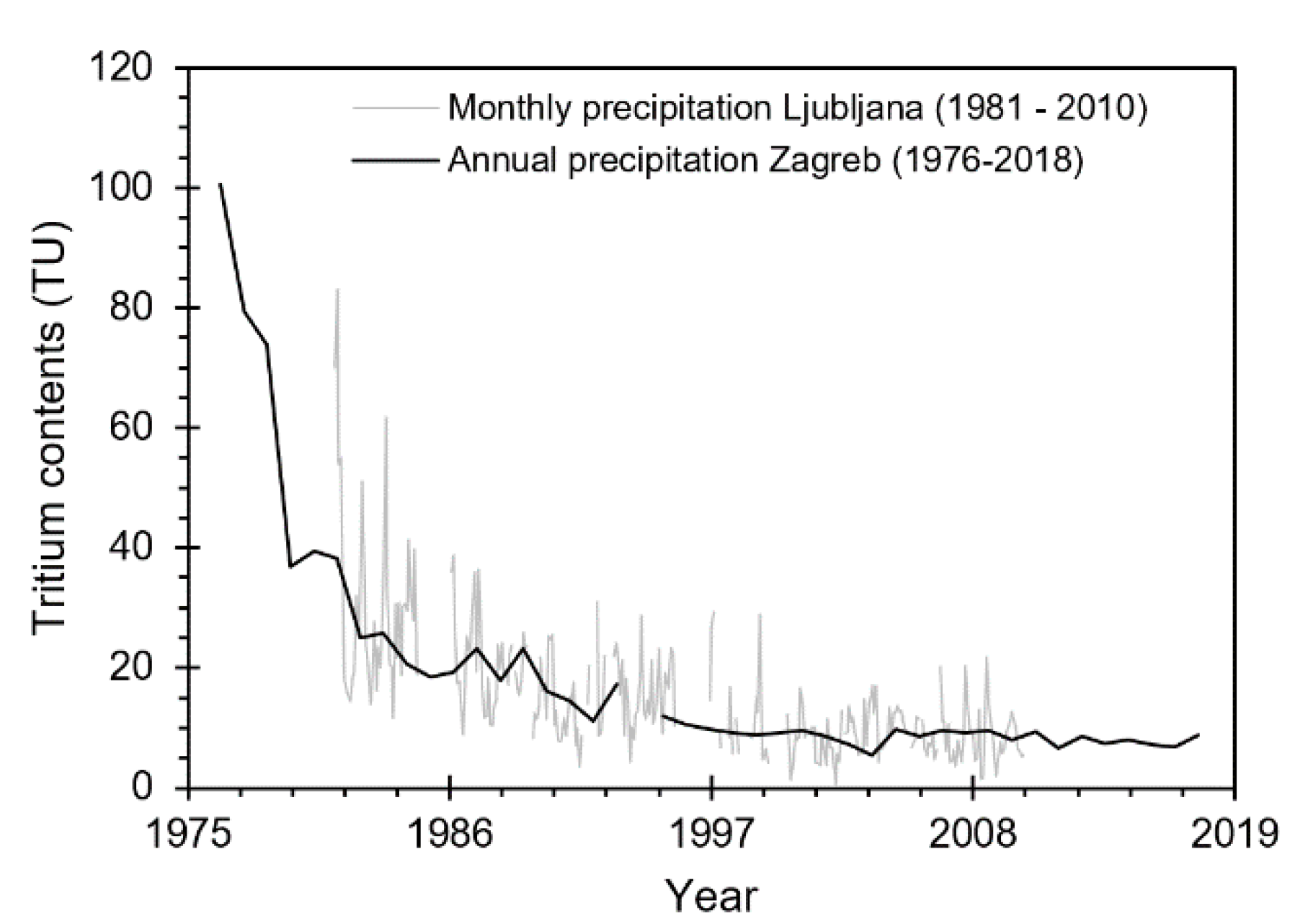Hydrogeochemical Characterization of a Warm Spring System in a Carbonate Mountain Range of the Eastern Julian Alps, Slovenia
Abstract
1. Introduction
2. Study Area Settings
2.1. Geographical Settings
2.2. Geological Settings
2.3. Hydrogeological and Thermal Settings
3. Methods
3.1. Data Acquisition
3.2. Data Processing
4. Results
4.1. Major Ion Chemistry
4.2. Saturation Indices
4.3. Mixing of Groundwaters
4.4. Origin of Waters and Recharge Altitudes
4.5. Residence Time
5. Discussion
6. Conclusions
Author Contributions
Funding
Acknowledgments
Conflicts of Interest
References
- Gleeson, T.; Manning, A.H. Regional groundwater flow in mountainous terrain: Three-dimensional simulations of topographic and hydrogeologic controls. Water Resour. Res. 2008, 44, W10403. [Google Scholar] [CrossRef]
- Garven, G. Continental-scale groundwater flow and geologic processes. Annu. Rev. Earth Planet. Sci. 1995, 23, 89–118. [Google Scholar] [CrossRef]
- Cao, G.L.; Han, D.M.; Currell, M.J.; Zheng, C.M. Revised conceptualization of the North China Basin groundwater flow system: Groundwater age, heat and flow simulations. J. Asian Earth Sci. 2016, 127, 119–136. [Google Scholar] [CrossRef]
- Bowen, R. Geothermal Resources, 2nd ed.; Elsevier Applied Science: London, UK, 1989; p. 485. [Google Scholar]
- Hochstein, P.M. Assessment and Modelling of Geothermal Reservoirs (Small Utilization Schemes). Geothermics 1988, 17, 15–49. [Google Scholar] [CrossRef]
- Sonney, R. Groundwater Flow, Heat and Mass Transport in Geothermal Systems of a Central Alpine Massif. The Cases of Lavey-Les-Bains, Saint-Gervais-Les-Bains and Val d’Illiez. Ph.D. Thesis, University of Neuchâtel, Neuchâtel, Switzerland, 2010. [Google Scholar]
- Rybach, L. Slowly moving thermal/mineral waters in deep crystalline basement. Environ. Geol. 2009, 58, 1645–1651. [Google Scholar] [CrossRef]
- Rybach, L.; Eugster, W.; Griesser, J.C. Die geothermischen Verhältnisse in der Nordschweiz. Eclogae Geol. Helv. 1987, 80, 531–534. [Google Scholar]
- Bianchetti, G.; Roth, P.; Vuataz, F.D.; Vergain, J. Deep groundwater circulation in the Alps: Relations between water infiltration, induced seismicity and thermal springs. The case of Val d’Illiez, Wallis. Eclogae Geol. Helv. 1992, 85, 291–305. [Google Scholar]
- Sonney, R.; Vuataz, F.D. Properties of geothermal fluids in Switzerland: A new interactive database. Geothermics 2008, 37, 496–509. [Google Scholar] [CrossRef]
- Sonney, R.; Vuataz, F.D. Numerical modelling of Alpine deep flow systems: A manegement and prediction tool for an exploited geothermal reservoir (Lavey-les-Bains, Switzerland). Hydrogeol. J. 2009, 17, 601–616. [Google Scholar] [CrossRef]
- Petrini, R.; Italiano, F.; Ponton, M.; Slejko, F.F.; Aviani, U.; Zini, L. Geochemistry and isotope geochemistry of the Monfalcone thermal waters (northern Italy): Inference on the deep geothermal reservoir. Hydrogeol. J. 2013, 21, 1275–1287. [Google Scholar] [CrossRef]
- Lapanje, A.; Rman, N. Thermal and thermomineral water. In The Geology of Slovenia; Pleničar, M., Ogorelec, B., Novak, M., Eds.; Geological Survey of Slovenia: Ljubljana, Slovenia, 2009; pp. 553–560. [Google Scholar]
- Lapanje, A. Izvor in kemijska sestava termnalnih in termomineralnih vod v Sloveniji. (Origin and chemical composition of thermal and thermomineral waters in Slovenia). Geologija 2006, 49, 347–370. [Google Scholar] [CrossRef]
- Zmazek, B.; Italiano, F.; Živčić, M.; Vaupotič, J.; Kobal, I.; Martinelli, G. Geochemical monitoring of thermal waters in Slovenia: Relationships to seismic activity. Appl. Radiat. Isot. 2002, 57, 919–930. [Google Scholar] [CrossRef]
- Zmazek, B.; Todorovski, L.; Živčić, M.; Džeroski, J.; Vaupotič, J.; Kobal, I. Radon in a thermal spring: Identification of anomalies related to seismic activity. Appl. Radiat. Isot. 2005, 64, 725–734. [Google Scholar] [CrossRef] [PubMed]
- Philipp, S. Hydrochemistry and Isotopic Analysis of Deep (Partly Thermal) Wells and Springs in NW-Slovenia. Ph.D. Thesis, Technische Universität Darmstadt, Darmstadt, Germany, 2015. [Google Scholar]
- Arnórsson, S.; Stefánsson, A.; Bjarnason, J. Fluid-fluid interaction in geothermal systems. Rev. Mineral. Geochem. 2007, 65, 259–312. [Google Scholar] [CrossRef]
- Zhang, Y.; Xu, M.; Li, X.; Qi, J.; Zhang, Q.; Guo, J.; Yu, L.; Zhao, R. Hydrochemical characteristics and multivariate statistical analysis of natural water system: A case study in Kangding County, Southwestern China. Water 2018, 10, 80. [Google Scholar] [CrossRef]
- Qiu, X.; Wang, Y.; Wang, Z.; Regenauer-Lieb, K.; Zhang, K.; Liu, J. Determining the origin, circulation path and residence time of geothermal groundwater using multiple isotopic techniques in the Heyuan Fault Zone of Southern China. J. Hydrol. 2008, 567, 339–350. [Google Scholar] [CrossRef]
- Arnórsson, S. Geothermal systems in Iceland: Structure and conceptual models I. High-temperature areas. Geothermics 1995, 24, 561–602. [Google Scholar]
- Hilberg, S. Review: Natural tracers in fractured hard-rock aquifers in the Austrian part of the Eastern Alps—previous approaches and future perspectives for hydrogeology in mountain regions. Hydrogeol. J. 2016, 24, 1091–1105. [Google Scholar] [CrossRef]
- Michard, G. Behaviour of major elements and some trace elements (Li, Rb, Cs, Sr, Fe, Mn, W, F) in deep hot waters from granitic areas. Chem. Geol. 1990, 89, 117–134. [Google Scholar] [CrossRef]
- Rman, N. Hydrogeochemical and isotopic tracers for identification of seasonal and long-term over-exploitation of the Pleistocene thermal waters. Environ. Monit. Assess. 2016, 188, 242–262. [Google Scholar] [CrossRef]
- Clark, I.; Fritz, P. Environmental Isotopes in Hydrogeology; CRC Press: New York, NY, USA, 1997; p. 328. [Google Scholar]
- Calligaris, C.; Mezga, K.; Slejko, F.F.; Urbanc, J.; Zini, L. Groundwater Characterization by Means of Conservative (δ18O and δ2H) and Non-Conservative (87Sr/86Sr) Isotopic Values: The Classical Karst Region Aquifer Case (Italy–Slovenia). Geoscience 2018, 8, 321. [Google Scholar] [CrossRef]
- Szőcs, T.; Rman, N.; Süveges, M.; Palcsu, L.; Tóth, G.; Lapanje, A. The application of isotope and chemical analyses in managing transboundary groundwater resources. Appl. Geochem. 2013, 32, 95–107. [Google Scholar]
- Zega, M.; Rožič, B.; Gaberšek, M.; Kanduč, T.; Žvab Rožič, P.; Verbovšek, T. Mineralogical, hydrogeochemical and isotopic characteristics of the Žveplenica sulphide karstic spring (Trebuša Valley, NW Slovenia). Environ. Earth Sci. 2015, 74, 3287–3300. [Google Scholar] [CrossRef]
- Rman, N.; Lapanje, A.; Szőcs, T.; Palcsu, L.; Junež, P. Origin of high mineralized mineral water and gas in Rogaška slatina, Slovenia. In Proceedings of the 2nd International Interdisciplinary Conference on Mineral Waters, Vila de Luso, Portugal, 26–31 March 2017. [Google Scholar]
- Brenčič, M. Hydrogeochemistry of Coastal Carbonate Aquifer in Lucij-Portorož (Gulf of Trieste, Northern Adriatic Sea, Slovenia). Acta Carsologica 2009, 38, 179–196. [Google Scholar]
- Cerar, S.; Urbanc, J. Carbonate chemistry and isotope characteristics of groundwater of Ljubljansko Polje and Ljubljansko Barje aquifers in Slovenia. Sci. World J. 2013, 2013, 948394. [Google Scholar] [CrossRef]
- Mezga, K. Natural Hydrochemical Background and Dynamics of Groundwater in Slovenia. Ph.D. Thesis, University of Nova Gorica, Nova Gorica, Slovenia, 2014. [Google Scholar]
- Kanduč, T.; Mori, N.; Kocman, D.; Stibilj, V.; Grassa, F. Hydrogeochemistry of Alpine springs from North Slovenia: Insights from stable isotopes. Chem. Geol. 2012, 300–301, 40–54. [Google Scholar] [CrossRef]
- Verbovšek, T.; Kanduč, T. Isotope Geochemistry of Groundwater from Fractured Dolomite Aquifers in Central Slovenia. Aquat. Geochem. 2015, 22, 131–151. [Google Scholar] [CrossRef]
- Torkar, A.; Brenčič, M.; Vreča, P. Chemical and isotopic characteristics of groundwater-dominated Radovna River (NW Slovenia). Environ. Earth Sci. 2016, 75, 1296–1314. [Google Scholar] [CrossRef]
- Torkar, A.; Brenčič, M. Spatio-temporal distribution of discharges in the Radovna River valley at low water conditions. Geologija 2015, 58, 47–56. [Google Scholar] [CrossRef]
- Archive of Weather Observations. Slovenian Environment Agency. Available online: http://meteo.arso.gov.si (accessed on 18 March 2019).
- Buser, S. Osnovna Geološka Karta SFRJ 1: 100.000. Tolmač Lista Celovec (Klagenfurt); Zvezni Geološki Zavod: Beograd, Serbia, 1980; p. 62. [Google Scholar]
- Buser, S. Osnovna Geološka Karta SFRJ 1: 100.000. Tolmač Listov Tolmin in Videm (Udine); Zvezi Geološki Zavod: Beograd, Serbia, 1986; p. 103. [Google Scholar]
- Jurkovšek, B. Osnovna Geološka Karta SFRJ. 1:100.000. Tolmač Listov Beljak in Ponteba; Zvezni Geološki Zavod: Beograd, Serbia, 1987; p. 58. [Google Scholar]
- Goričan, Š.; Žibret, L.; Košir, A.; Kukoč, D.; Horvat, A. Stratigraphic correlation and structural position of Lower Cretaceous flysch-type deposits in the eastern Southern Alps (NW Slovenia). Int. J. Earth Sci. 2018, 107, 2933–2953. [Google Scholar] [CrossRef]
- Gale, L.; Kolar-Jurkovšek, T.; Karničnik, B.; Celarc, B.; Goričan, Š.; Rožič, B. Triassic deep-water sedimentation in the Bled Basin, eastern Julian Alps, Slovenia. Geologija 2019, 62, 153–173. [Google Scholar] [CrossRef]
- Placer, L. Contribution to the macrotectonic subdivision of the border region between Southern Alps and External Dinarides. Geologija 1999, 41, 223–255. [Google Scholar] [CrossRef]
- Bavec, M.; Verbič, T. The extent of Quaternary glaciations in Slovenia. In Developments in Quaternary Science; Ehlers, J., Gibbard, P.L., Eds.; Elsevier Science: Amsterdam, The Netherlands, 2004; Volume 2, pp. 385–388. [Google Scholar]
- Serianz, L. Tri-dimensional Model of the Radovna Glacier from Last Glacial Period. Geologija 2016, 59, 193–204. [Google Scholar] [CrossRef]
- Lapanje, A.; Budkovič, T.; Rikanovič, R.; Rajver, D.; Rman, N.; Matoz, T. Hidrogeološke Strokovne Osnove za Izkoriščanje Termalne vode na Bledu; Geological Survey of Slovenia: Ljubljana, Slovenia, 2009. [Google Scholar]
- Kazemi, G.A.; Lehr, J.H.; Perrochet, P. Groundwater Age; John Wiley & Sons: Hoboken, NJ, USA, 2006. [Google Scholar]
- National Monitoring of Chemical Status. Slovenian Environment Agency. Available online: http://www.arso.gov.si/vode (accessed on 10 January 2019).
- Croghan, C.W.; Egeghy, P.P. Methods of dealing with values below the limit of detection using SAS. In Proceedings of the Southeastern SAS User Group, St. Petersburg, FL, USA, 22–24 September 2003; Environmental Protection Agency: Washington, DC, USA, 2003. [Google Scholar]
- Piper, A.M. A graphic procedure in the geochemical interpretation of water-analyses. Eos Trans. Am. Geophys. Union 1944, 25, 914–928. [Google Scholar] [CrossRef]
- Gibbs, R.J. Mechanisms controlling world water chemistry. Science 1970, 170, 1088–1090. [Google Scholar] [CrossRef]
- Marandi, A.; Shand, P. Groundwater chemistry and the Gibbs Diagram. Appl. Geochem. 2018, 97, 209–212. [Google Scholar] [CrossRef]
- Mayo, L.; Loucks, M.D. Solute and isotopic geochemistry and ground water flow in the central Wasatch Range, Utah. J. Hydrol. 1995, 172, 31–59. [Google Scholar] [CrossRef]
- López-Chicano, M.; Bouamama, M.; Vallejos, A.; Pulido-Bosch, A. Factors which determine the hydrogeochemical behaviour of karstic springs. A case study from the Betic Cordilleras, Spain. Appl. Geochem. 2001, 16, 1179–1192. [Google Scholar]
- Argamasilla, M.; Barbera, J.A.; Andreo, B. Factors controlling groundwater salinization and hydrogeochemical processes in coastal aquifers from southern Spain. Sci. Total Environ. 2017, 580, 50–68. [Google Scholar] [CrossRef]
- Wickham, H.; François, R.; Henry, L.; Kirill, M. CRAN-Package ‘dplyr’, A Grammar of Data Manipulation. Available online: https://cran.r-project.org/web/packages/dplyr/dplyr.pdf (accessed on 15 July 2018).
- R Development Core Team. R: A Language and Environment for Statistical Computing; R Foundation for Statistical Computing Vienna: Vienna, Austria, 2018. [Google Scholar]
- Krajcar Bronič, I.; Barešić, J.; Borković, D.; Sironić, A.; Mikelić Lovrenčić, I.; Vreča, P. Long-Term Isotope Records of Precipitation in Zagreb, Croatia. Water 2020, 12, 226. [Google Scholar] [CrossRef]
- Craig, H. Isotope variations in meteoric waters. Science 1961, 133, 1702–1703. [Google Scholar] [CrossRef]
- Vreča, P.; Krajcar Bronič, I.; Leis, A.; Brenčič, M. Isotopic composition of precipitation in Ljubljana (Slovenia). Geologija 2008, 51, 169–180. [Google Scholar] [CrossRef]
- Gat, J.R.; Carmi, I. Evolution of the isotopic composition of atmospheric waters in the Mediterranean Sea area. J. Geophys. Res. 1970, 75, 3039–3048. [Google Scholar] [CrossRef]
- Giustini, F.; Brilli, M.; Patera, A. Mapping oxygen stable isotopes of precipitation in Italy. J. Hydrol. Reg. Stud. 2016, 8, 162–181. [Google Scholar] [CrossRef]
- Jasechko, S. Partitioning young and old groundwater with geochemical tracers. Chem. Geol. 2016, 427, 35–42. [Google Scholar] [CrossRef]
- Vreča, P.; Krajcar Bronič, I.; Leis, A.; Demšar, M. Isotopic composition of precipitation at the station Ljubljana (Reaktor), Slovenia—period 2007–2010. Geologija 2014, 57, 217–230. [Google Scholar] [CrossRef]
- Rman, N. Uporabnost ionskih geotermometrov na slovenskih termalnih vodah = Applicability of ionic geothermometers on Slovene thermal waters. In Proceedings of the 19 Posvetovanje Slovenskih Geologov, Ljubljana, Slovenia, 19–26 July 2009. [Google Scholar]
- Leibundgut, C.; Maloszewski, P.; Kulls, C. Tracers in hydrology, 1st ed.; John Wiley & Sons: Hoboken, NJ, USA, 2014. [Google Scholar]
- Tóth, J. A theoretical analysis of groundwater flow in small drainage basins. J. Geophys. Res. 1963, 68, 4795–4812. [Google Scholar] [CrossRef]
- Hilberg, S.; Kreuzer, M. Identification of a deep flow system in a dolomitic alpine aquifer: Case study Wimmerbauern spring, Bad Ischl. Aust. J. Earth Sci. 2013, 106, 16–25. [Google Scholar]
- Hilberg, S.; Riepler, F. Interaction of various flow systems in small alpine catchments: Conceptual model of the upper Gurk Valley aquifer, Carinthia, Austria. Hydrogeol. J. 2016, 24, 1231–1244. [Google Scholar] [CrossRef]
- Meybeck, M. River water quality, global ranges time and space variabilities. Verh. Int. Ver. Limnol. 1996, 26, 81–96. [Google Scholar]
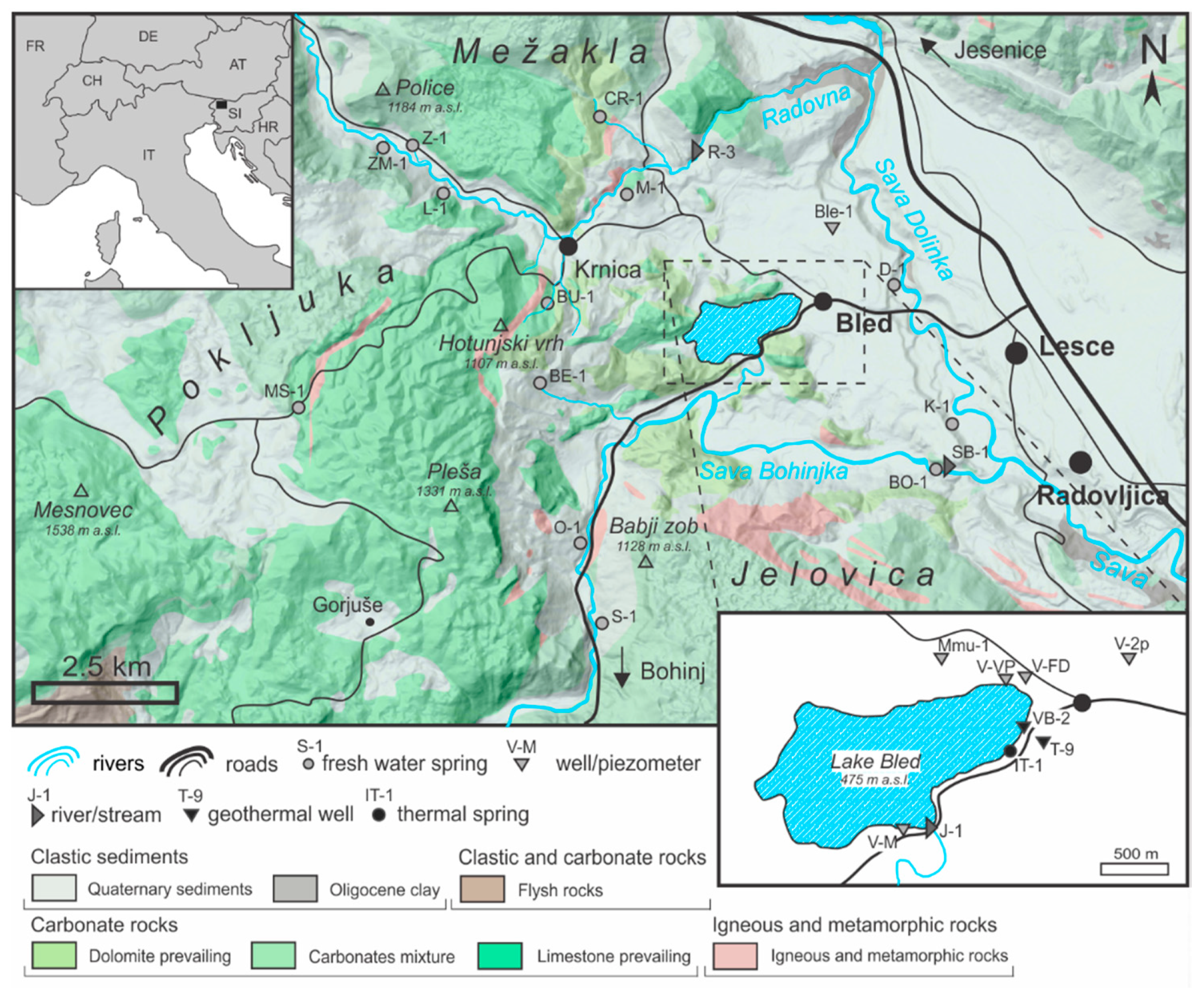
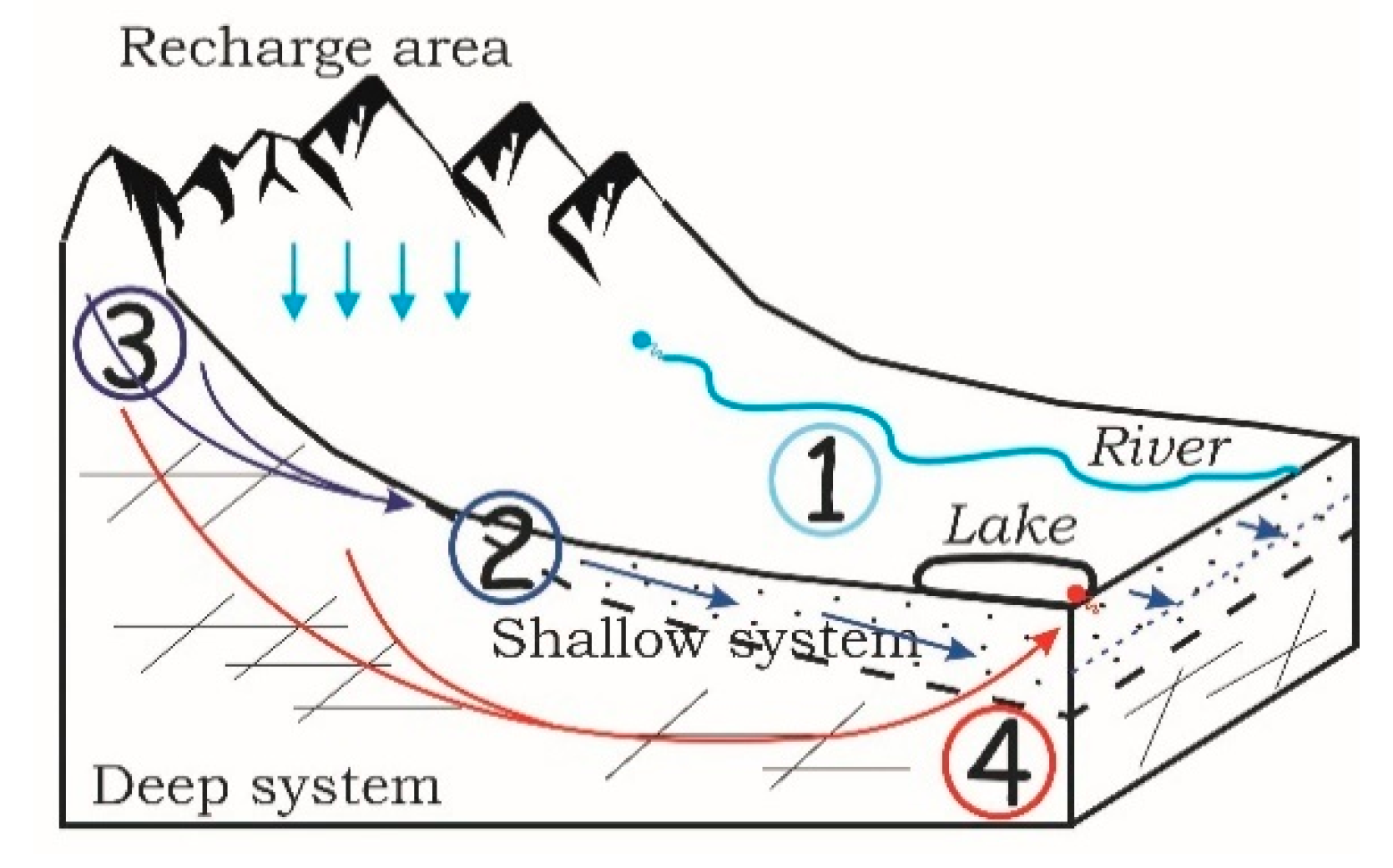

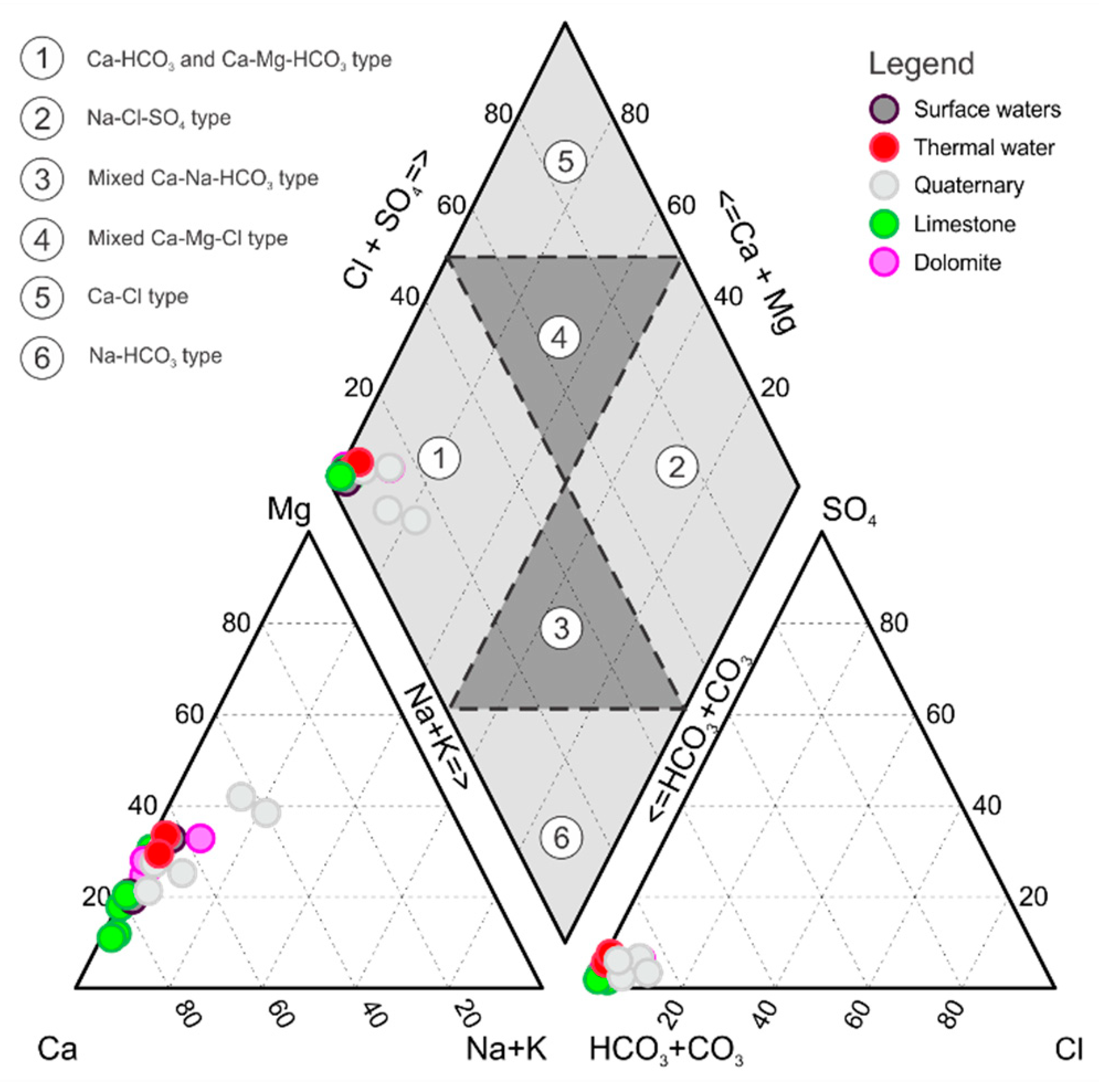
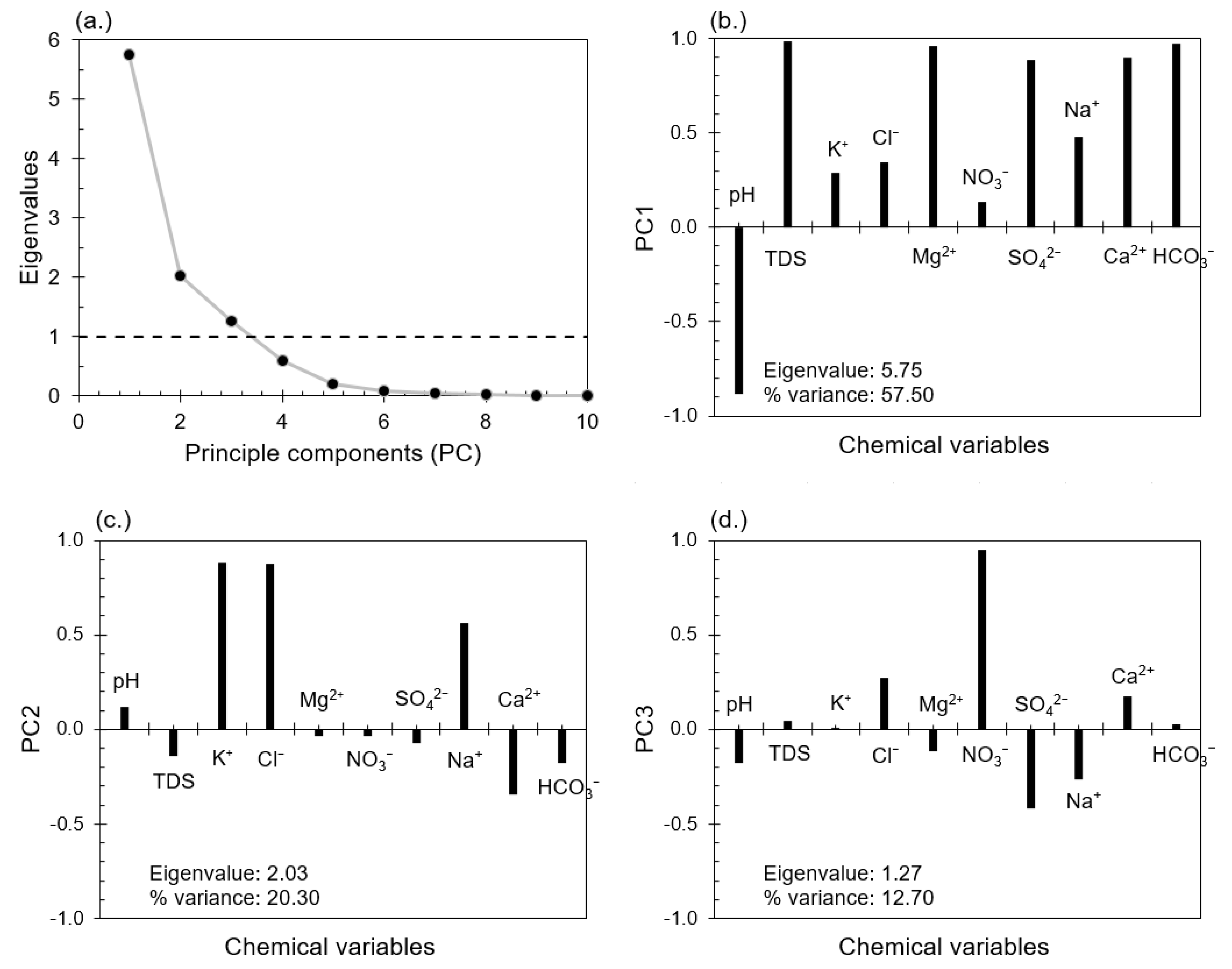
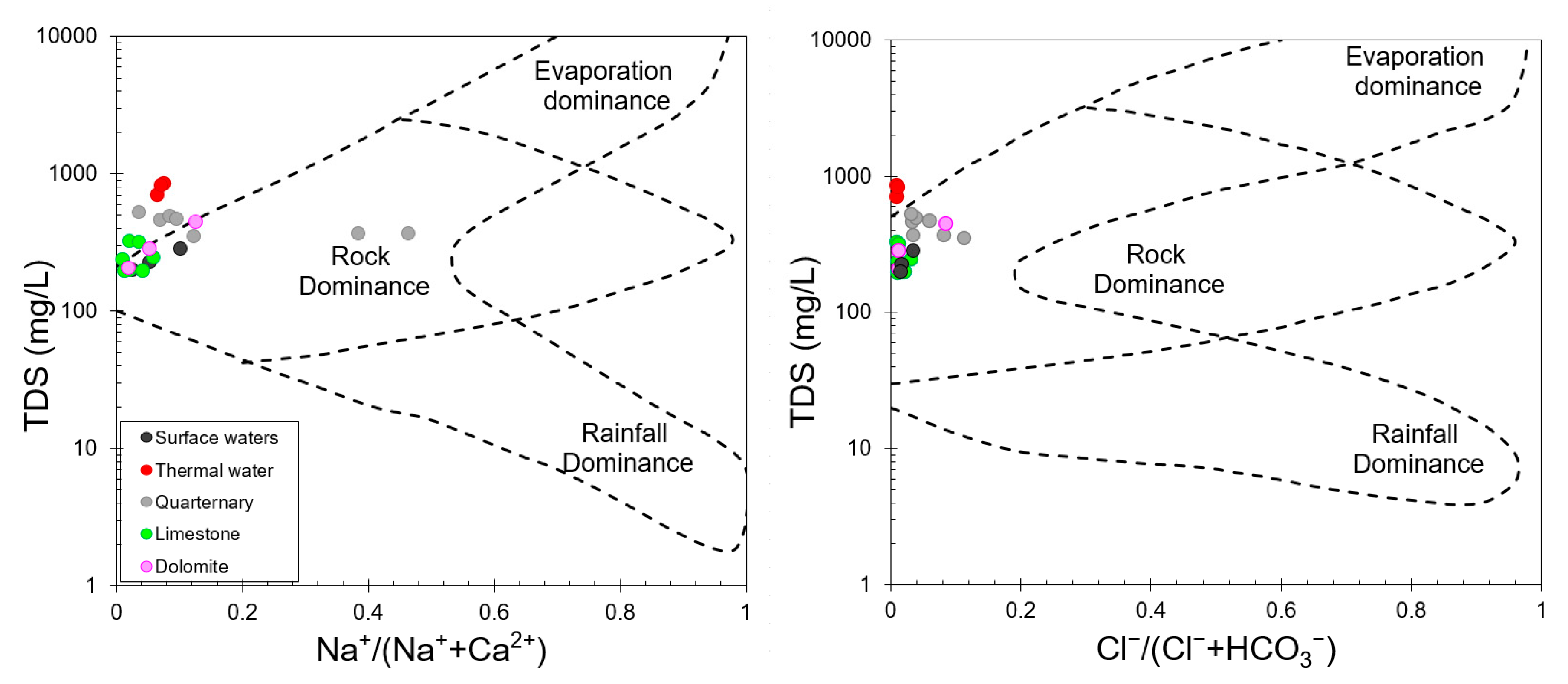
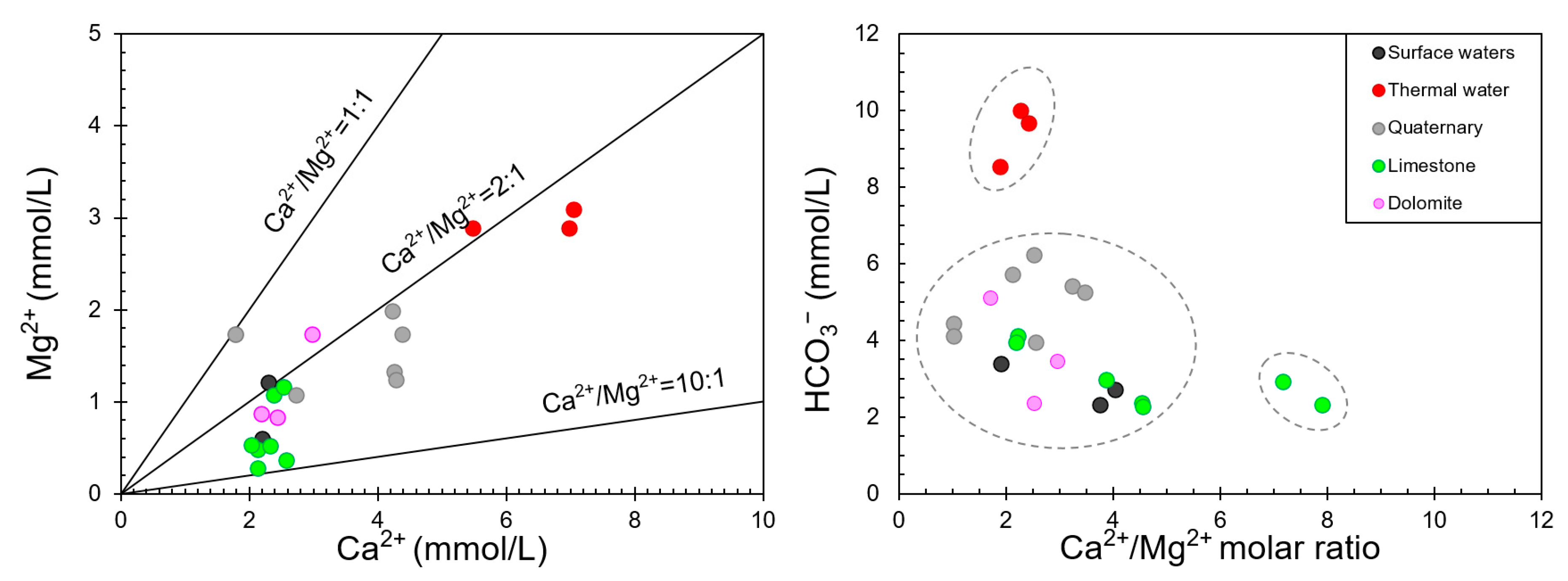
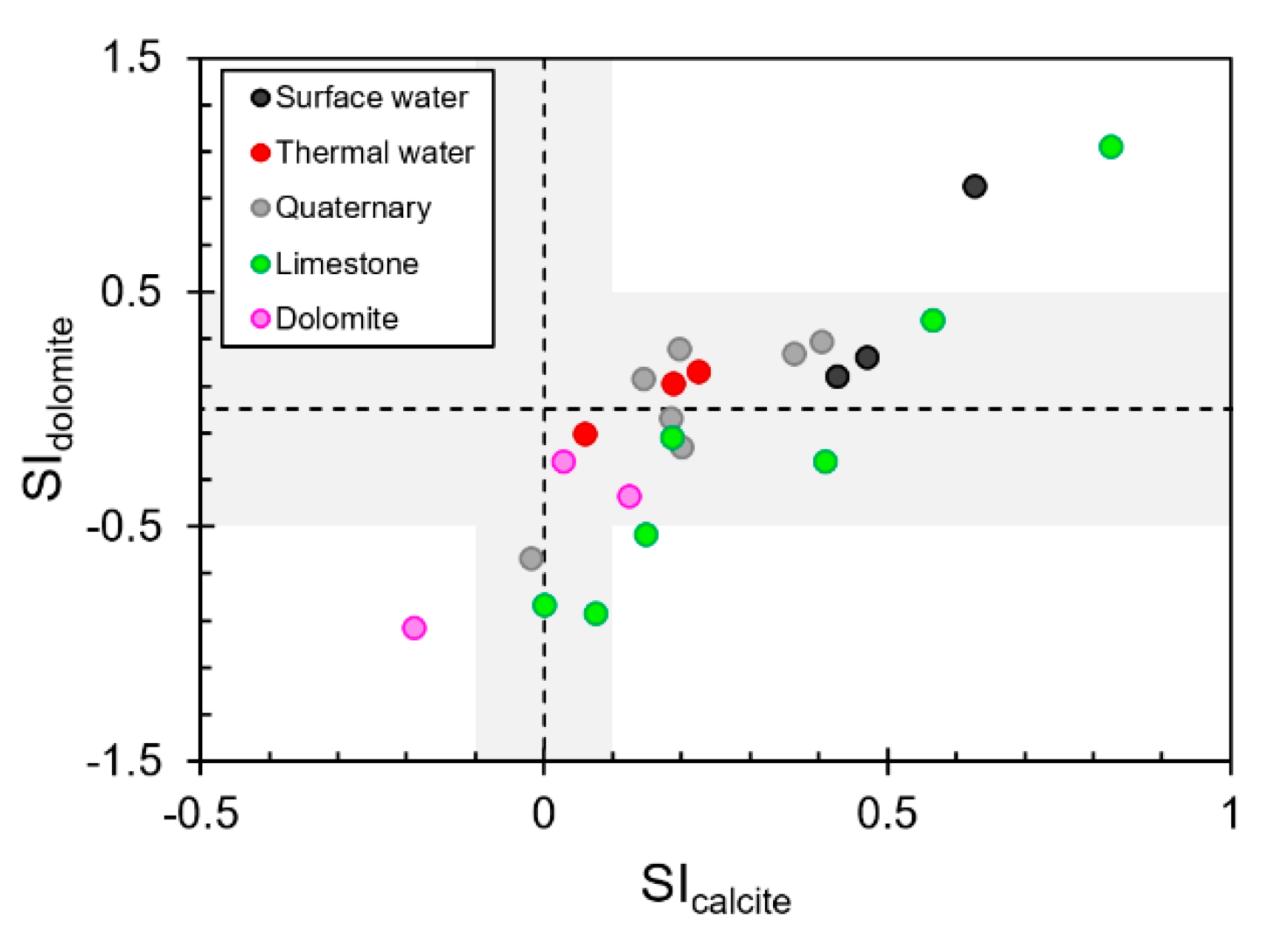
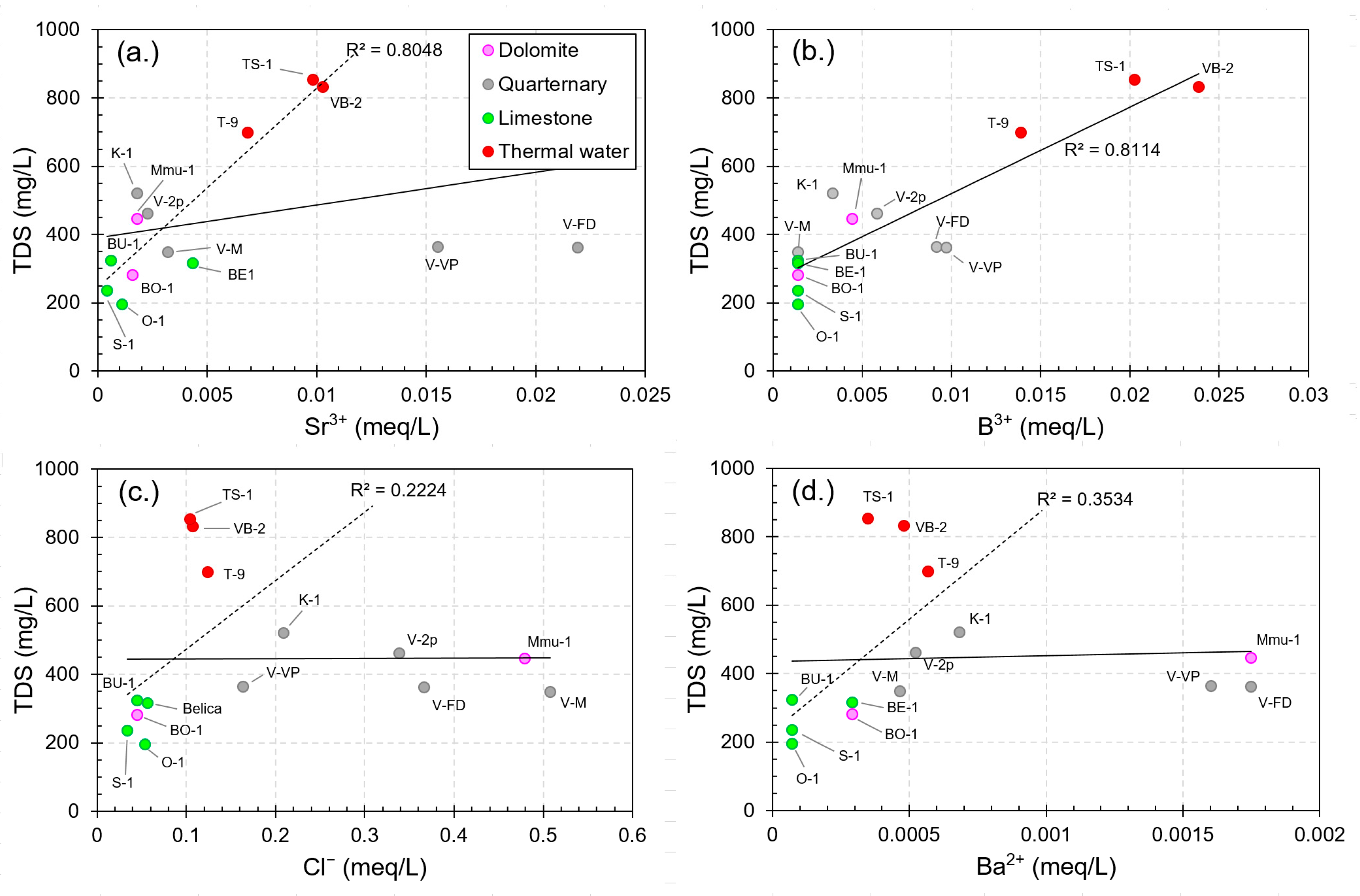


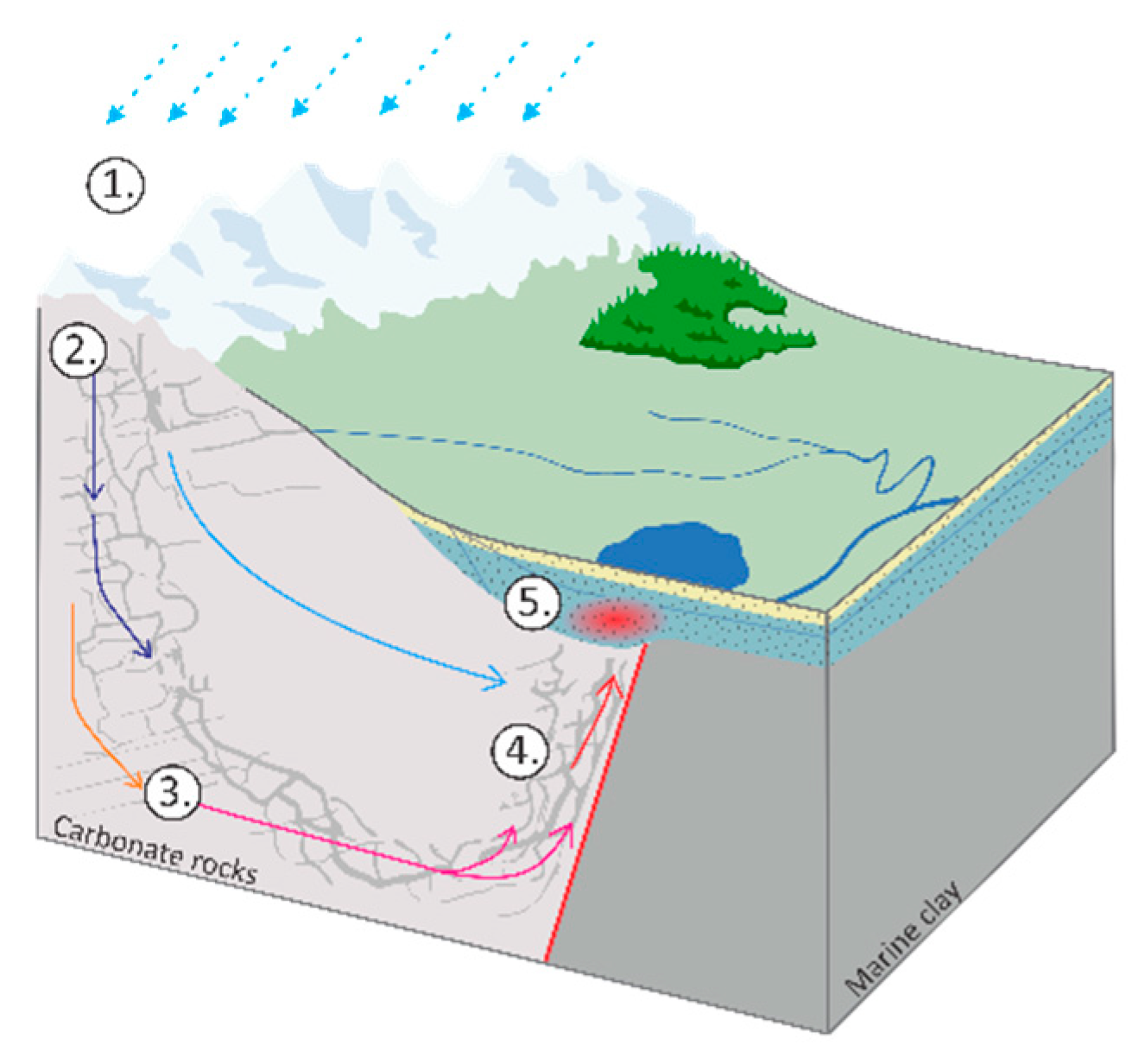
| Object ID | Object | Type | Hydrogeol. System | Prevailing Lithology | Chemical Analysis | Isotopic Analysis | ||
|---|---|---|---|---|---|---|---|---|
| Major | Micro | δ18O, δ2H | 3H | |||||
| SB-1 | Sava Bohinjka | River | SW | 18 * | ||||
| R-3 | Radovna | River | SW | 9 * | ||||
| J-1 | Jezernica | Stream | SW | 4 * | 3 | |||
| Ble-1 | Ble-1/13 | Piezometer | SI | Quaternary sediments | 2 * | |||
| D-1 | Dobravca | Spring | SI | Quaternary sediments | 13 * | 1 * | ||
| V-VP | V-VP | Piezometer | SI | Quaternary sediments | 1 | 1 | 3 | 1 |
| V-M | V-M | Piezometer | SI | Quaternary sediments | 1 | 1 | 3 | 1 |
| V-FD | V-FD | Piezometer | SI | Quaternary sediments | 1 | 1 | 3 | 1 |
| V-2p | V-2p | Piezometer | SI | Quaternary sediments | 1 | 1 | 3 | 1 |
| K-1 | Koritno | Spring | SI | Quaternary sediments | 1 | 1 | 3 | 1 |
| Mmu-1 | Mmu-1/18 | Well | SKF | Dolomite | 1 | 1 | 4 | 1 |
| CR-1 | Rečica | Spring | SKF | Dolomite | 3 * | 2 | ||
| BO-1 | Bodešče | Spring | SKF | Dolomite | 1 | 1 | 4 | 1 |
| Z-1 | Zatrep | Spring | SKF | Limestone | 3 * | 1 | ||
| ZM-1 | Zrmzlek | Spring | SKF | Limestone | 4 * | 2 | ||
| L-1 | Lipnik | Spring | SKF | Limestone | 7 * | 2 | ||
| O-1 | Obrne | Spring | SKF | Limestone | 1 | 1 | 4 | 1 |
| S-1 | Soteska | Spring | SKF | Limestone | 1 | 1 | 4 | 1 |
| BU-1 | Budin | Spring | SKF | Limestone | 1 | 1 | 2 | 1 |
| BE-1 | Belica | Spring | SKF | Limestone | 1 | 1 | 4 | 1 |
| M-1 | Mevkuž | Spring | SKF | Limestone | 2 | |||
| MS-1 | Mrzli Studenec | Spring | SKF | Limestone | 3 | |||
| T-9 | T-9/68 | Well | GA | Dolomite | 3 | 1 | 6 | 1 |
| VB-2 | VB-2/04 | Well | GA | Quaternary sediments | 4 | 1 | 6 | 1 |
| TS-1 | Toplice | Spring | GA | Dolomite | 3 | 1 | 6 | 1 |
| Location | Sampling Period 2 | T | pH | EC | TDS | Ca2+ | Mg2+ | Na+ | K+ | HCO3− | SO42− | Cl− | NO3− | B3+ | Sr2+ | Ba2+ | δ18O | δ2H | 3H |
|---|---|---|---|---|---|---|---|---|---|---|---|---|---|---|---|---|---|---|---|
| °C | - | μS/cm | mg/L | µg/L | ‰ | TU | |||||||||||||
| SB-1 | 2007–2016 1 | 9.2 | 8.2 | 266 | 225.0 | 45.0 | 6.8 | 1.5 | 0.4 | 165.0 | 2.4 | 1.8 | 2.3 | ||||||
| R-3 | 2005–2007 1 | 7.3 | 8.4 | 254 | 196.7 | 44.3 | 7.2 | 0.7 | 0.2 | 140.0 | 2.6 | 1.4 | 0.5 | ||||||
| J-1 | 2006 1 | 14.3 | 8.3 | 327 | 283.0 | 46.2 | 14.6 | 3.0 | 0.9 | 205.7 | 7.4 | 4.4 | 0.7 | −8.40 | −56.9 | ||||
| Ble-1 | 2014 1 | 12.6 | 7.4 | 498 | 458.6 | 85.5 | 16.0 | 3.7 | 0.9 | 330.0 | 4.8 | 6.7 | 11.0 | ||||||
| D-1 | 2007–2014 1 | 10.9 | 7.4 | 527 | 491.2 | 85.0 | 24.1 | 4.6 | 0.6 | 347.7 | 7.9 | 8.3 | 13.0 | 0.0 | 90.0 | 43.0 | −8.60 | −58.4 | |
| V-VP | 2019 | 8.7 | 7.9 | 392 | 362.3 | 36.0 | 21.0 | 13.0 | 1.4 | 270.0 | 14.0 | 5.8 | 1.1 | 33.0 | 680.0 | 110.0 | −9.71 | −64.3 | <0.20 |
| V-M | 2019 | 10.7 | 7.9 | 383 | 348.6 | 55.0 | 13.0 | 4.5 | 9.6 | 240.0 | 7.4 | 18.0 | 1.1 | 5.0 | 140.0 | 32.0 | −8.31 | −56.8 | 3.00 ± 0.30 |
| V-FD | 2019 | 7.5 | 7.9 | 423 | 362.0 | 36.0 | 21.0 | 18.0 | 7.6 | 250.0 | 15.0 | 13.0 | 1.1 | 35.0 | 960.0 | 120.0 | −9.47 | −62.7 | <0.20 |
| V-2p | 2019 | 12.0 | 7.2 | 514 | 462.0 | 86.0 | 15.0 | 5.3 | 2.2 | 320.0 | 6.8 | 12.0 | 15.0 | 21.0 | 100.0 | 36.0 | −8.92 | −59,6 | 6.50 ± 0.40 |
| K-1 | 2019 | 8.9 | 7.6 | 566 | 521.0 | 88.0 | 21.0 | 1.9 | 4.8 | 380.0 | 5.1 | 7.4 | 13.0 | 12.0 | 78.0 | 47.0 | −8.56 | −57.6 | 4.80 ± 0.40 |
| Mmu-1 | 2018 | 13.0 | 7.4 | 485 | 445.1 | 60.0 | 21.0 | 5.0 | 13.0 | 310.0 | 18.0 | 17.0 | 1.1 | 16.0 | 79.0 | 120.0 | −9.33 | −62.4 | 1.40 ± 0.20 |
| CR-1 | 2005–2007 1 | 7.5 | 7.7 | 286 | 204.8 | 44.1 | 10.5 | 0.5 | 0.2 | 143.0 | 4.5 | 1.2 | 0.8 | −9.31 | −60.7 | ||||
| BO-1 | 2019 | 7.4 | 7.8 | 302 | 281.0 | 49.0 | 10.0 | 1.6 | 0.4 | 210.0 | 5.3 | 1.6 | 3.1 | 5.0 | 69.0 | 20.0 | −8.80 | −58.5 | 5.40 ± 0.40 |
| Z-1 | 2005 –2007 1 | 6.0 | 8.1 | 241 | 197.9 | 43.1 | 5.8 | 0.5 | 0.2 | 143.0 | 3.2 | 1.7 | 0.4 | −9.73 | −64.1 | ||||
| ZM-1 | 2005–2007 1 | 6.1 | 7.9 | 258 | 194.4 | 47.0 | 6.2 | 0.4 | 0.1 | 137.0 | 2.2 | 1.0 | 0.5 | −9.72 | −63.6 | ||||
| L-1 | 2007–2016 1 | 6.6 | 7.8 | 259 | 243.6 | 52.0 | 4.4 | 1.9 | 0.3 | 177.0 | 2.5 | 3.5 | 2.1 | −9.46 | −62.6 | ||||
| S-1 | 2019 | 6.4 | 8.4 | 259 | 236.0 | 41.0 | 6.4 | 0.3 | 0.4 | 180.0 | 2.6 | 1.2 | 4.0 | 5.0 | 19.0 | 5.0 | −9.46 | −62.4 | 5.30 ± 0.40 |
| O-1 | 2019 | 7.5 | 8.3 | 236 | 196.0 | 43.0 | 3.3 | 1.1 | 0.3 | 140.0 | 3.0 | 1.9 | 3.5 | 5.0 | 48.0 | 5.0 | −9.32 | −61.4 | 4.40 ± 0.30 |
| BU-1 | 2019 | 5.4 | 8.5 | 307 | 323.0 | 48.0 | 13.0 | 0.6 | 0.2 | 250.0 | 6.0 | 1.6 | 3.1 | 5.0 | 26.0 | 5.0 | −8.47 | −56.6 | 4.10 ± 0.30 |
| BE-1 | 2019 | 7.2 | 7.8 | 331 | 316.0 | 51.0 | 14.0 | 1.1 | 0.6 | 240.0 | 4.7 | 2.0 | 2.7 | 5.0 | 190.0 | 20.0 | −9.14 | −60.0 | 4.30 ± 0.30 |
| M-1 | - | - | - | - | - | - | - | −8.68 | −57.4 | ||||||||||
| MS-1 | - | - | - | - | - | - | - | −9.30 | −60.1 | ||||||||||
| T-9 | 2017–2018 1 | 19.0 | 6.9 | 700 | 698.9 | 110.0 | 35.0 | 4.5 | 1.1 | 520.0 | 24.0 | 3.2 | 1.1 | 50.0 | 300.0 | 39.0 | −9.37 | −62.7 | 2.07 ± 0.38 |
| VB-2 | 2017–2018 1 | 21.6 | 6.9 | 831 | 841.2 | 141.5 | 37.5 | 6.7 | 1.7 | 610.0 | 39.0 | 3.8 | 1.1 | 86.0 | 450.0 | 33.0 | −9.73 | −64.2 | 3.41 ± 0.28 |
| TS-1 | 2017–2018 1 | 21.8 | 6.9 | 823 | 816.0 | 140.0 | 35.0 | 6.3 | 1.6 | 590.0 | 38.0 | 4.0 | 1.1 | 73.0 | 10.0 | 24.0 | −9.68 | −64.5 | 2.98 ± 0.32 |
| Hydrogeol. | Prevailing | Statistics | N | T | pH | EC | TDS | Ca2+ | Mg2+ | Na+ | K+ | HCO3− | SO42− | Cl− | NO32− |
|---|---|---|---|---|---|---|---|---|---|---|---|---|---|---|---|
| System | Lithology | °C | / | μS/cm | mg/L | ||||||||||
| SW | - | Min | 3 | 7.3 | 8.2 | 254 | 196.7 | 44.3 | 6.8 | 0.7 | 0.2 | 140 | 2.4 | 1.4 | 0.5 |
| Max | 14.3 | 8.4 | 327 | 283 | 46.2 | 14.6 | 3 | 0.9 | 205.7 | 7.4 | 4.4 | 2.3 | |||
| Av | 10.3 | 8.3 | 282 | 234.9 | 45.2 | 9.5 | 1.7 | 0.5 | 170.2 | 4.1 | 2.5 | 1.2 | |||
| St. dev. | 3.6 | 0.1 | 38.9 | 44 | 1 | 4.4 | 1.2 | 0.4 | 33.2 | 2.9 | 1.6 | 1 | |||
| SI | Quaternary | Min | 7 | 7.5 | 7.2 | 383 | 348.6 | 36 | 13 | 1.9 | 0.6 | 240 | 4.8 | 5.8 | 1.1 |
| sediments | Max | 12.6 | 7.9 | 566 | 521 | 88 | 24.1 | 18 | 9.6 | 380 | 15 | 18 | 15 | ||
| Av | 10.2 | 7.6 | 472 | 429.4 | 67.4 | 18.7 | 7.3 | 3.9 | 305.4 | 8.7 | 10.2 | 7.9 | |||
| St. dev. | 1.9 | 0.3 | 71.9 | 70.3 | 24.3 | 4.1 | 5.9 | 3.6 | 52.9 | 4.1 | 4.4 | 6.5 | |||
| SKF | Limestone | Min | 7 | 5.4 | 7.8 | 236 | 194.4 | 41 | 3.3 | 0.3 | 0.1 | 137 | 2.2 | 1 | 0.4 |
| Max | 7.5 | 8.5 | 331 | 323 | 52 | 14 | 1.9 | 0.6 | 250 | 6 | 3.5 | 4 | |||
| Av | 6.5 | 8.1 | 270 | 243.8 | 46.4 | 7.6 | 0.8 | 0.3 | 181 | 3.5 | 1.8 | 2.3 | |||
| St. dev. | 3.2 | 0.2 | 110.6 | 122.8 | 8.1 | 6.2 | 2.3 | 7.3 | 84 | 7.6 | 9 | 1.3 | |||
| Dolomite | Min | 3 | 7.4 | 7.4 | 286 | 204.8 | 44.1 | 10 | 0.5 | 0.2 | 143 | 4.5 | 1.2 | 0.8 | |
| Max | 13 | 7.8 | 485 | 445.1 | 60 | 21 | 5 | 13 | 310 | 18 | 17 | 3.1 | |||
| Av | 9.3 | 7.6 | 358 | 310.3 | 51 | 13.8 | 2.4 | 4.5 | 221 | 9.3 | 6.6 | 1.7 | |||
| St. dev. | 0.7 | 0.3 | 35.3 | 55.3 | 4.2 | 4.2 | 0.6 | 0.2 | 47.1 | 1.4 | 0.8 | 1.4 | |||
| GA | Dolomite | Min | 3 | 19 | 6.9 | 700 | 698.9 | 110 | 35 | 4.5 | 1.1 | 520 | 24 | 3.2 | 1.1 |
| Max | 21.8 | 6.9 | 831 | 841.2 | 141.5 | 37.5 | 6.7 | 1.7 | 610 | 39 | 4 | 1.1 | |||
| Av | 20.8 | 6.9 | 785 | 785.4 | 130.5 | 35.8 | 5.8 | 1.5 | 573.3 | 33.7 | 3.7 | 1.1 | |||
| St. dev. | 1.6 | 0 | 733 | 75.9 | 17.8 | 1.4 | 1.2 | 0.3 | 47.3 | 8.4 | 0.4 | 0 | |||
© 2020 by the authors. Licensee MDPI, Basel, Switzerland. This article is an open access article distributed under the terms and conditions of the Creative Commons Attribution (CC BY) license (http://creativecommons.org/licenses/by/4.0/).
Share and Cite
Serianz, L.; Rman, N.; Brenčič, M. Hydrogeochemical Characterization of a Warm Spring System in a Carbonate Mountain Range of the Eastern Julian Alps, Slovenia. Water 2020, 12, 1427. https://doi.org/10.3390/w12051427
Serianz L, Rman N, Brenčič M. Hydrogeochemical Characterization of a Warm Spring System in a Carbonate Mountain Range of the Eastern Julian Alps, Slovenia. Water. 2020; 12(5):1427. https://doi.org/10.3390/w12051427
Chicago/Turabian StyleSerianz, Luka, Nina Rman, and Mihael Brenčič. 2020. "Hydrogeochemical Characterization of a Warm Spring System in a Carbonate Mountain Range of the Eastern Julian Alps, Slovenia" Water 12, no. 5: 1427. https://doi.org/10.3390/w12051427
APA StyleSerianz, L., Rman, N., & Brenčič, M. (2020). Hydrogeochemical Characterization of a Warm Spring System in a Carbonate Mountain Range of the Eastern Julian Alps, Slovenia. Water, 12(5), 1427. https://doi.org/10.3390/w12051427





